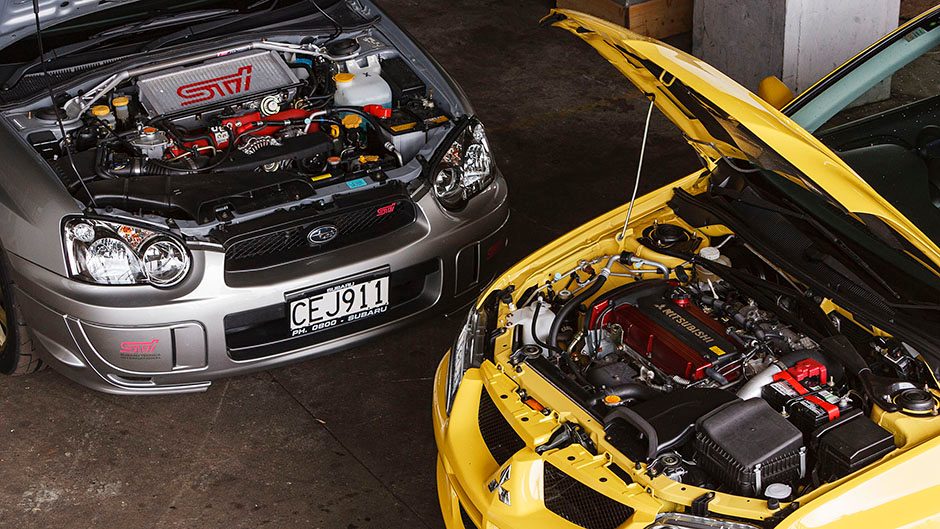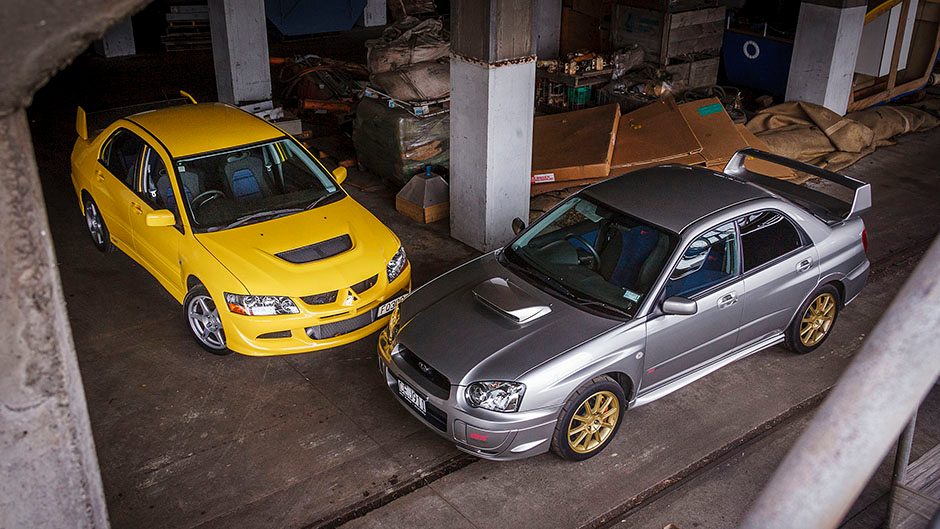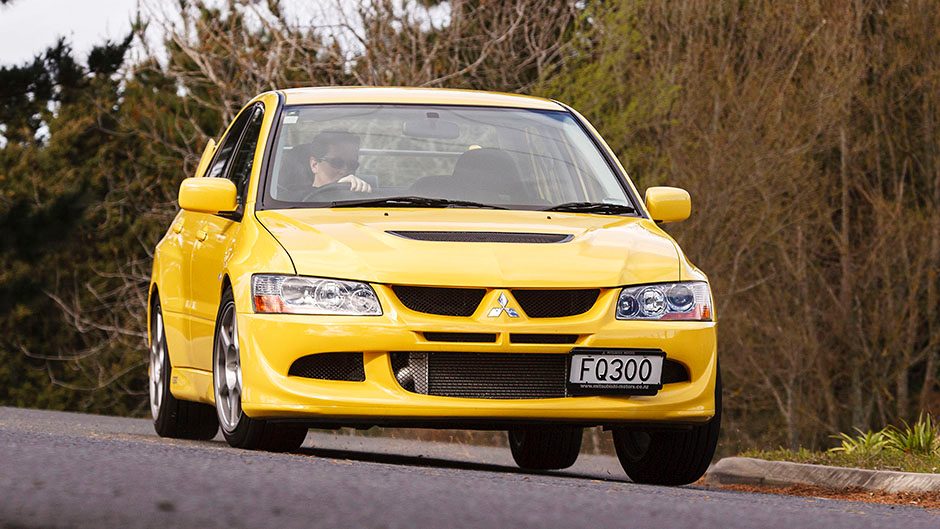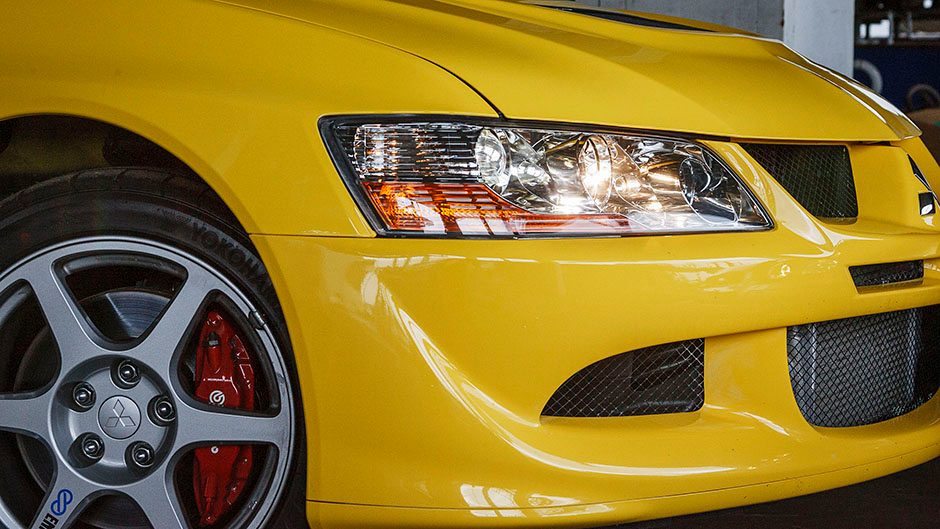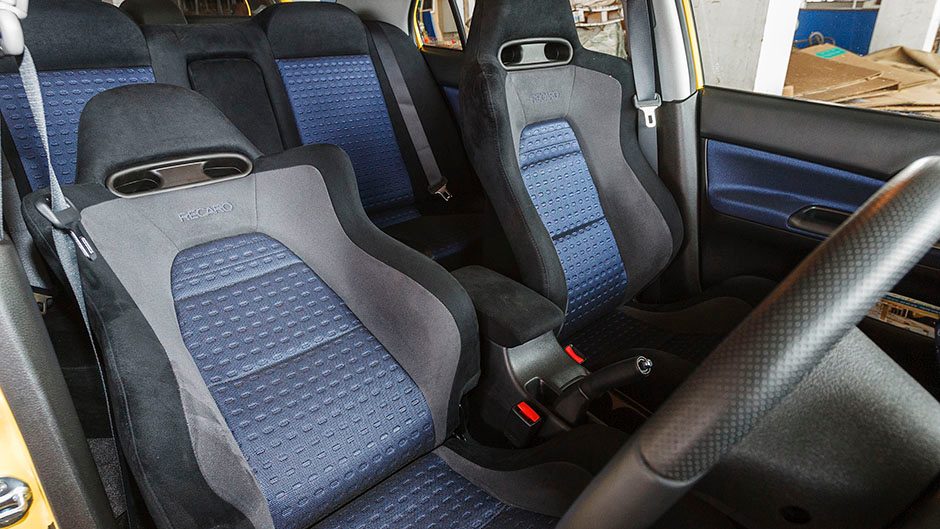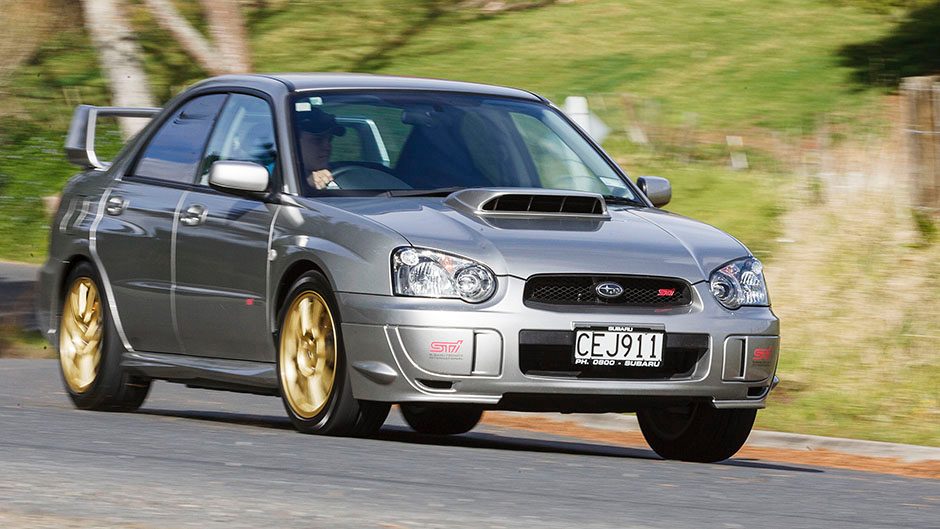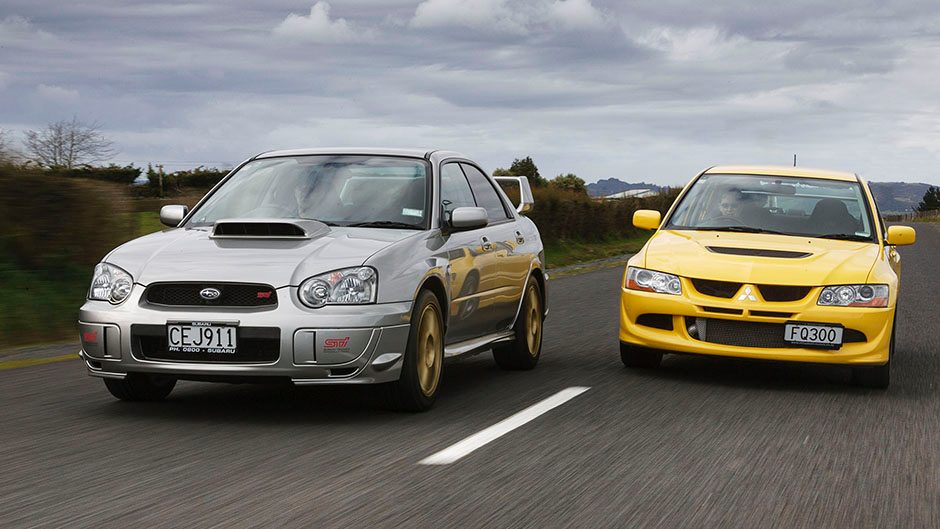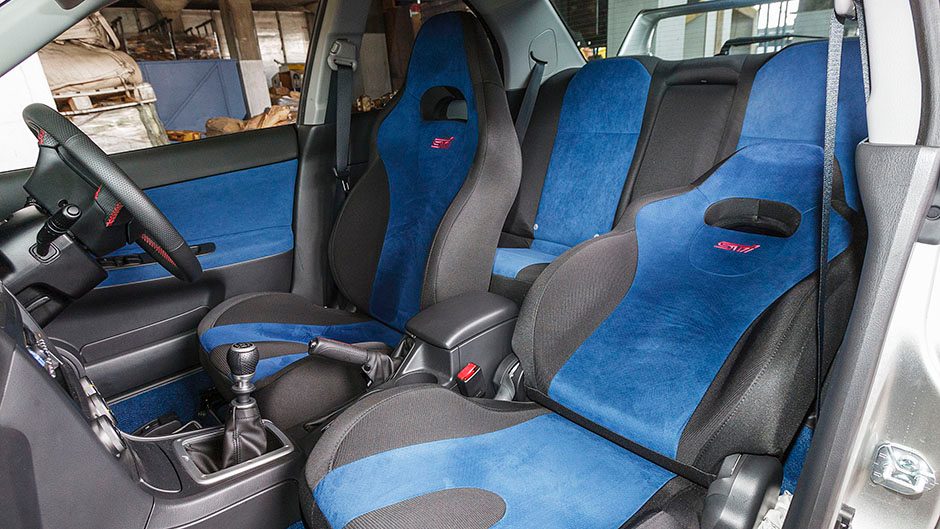2004 Mitsubishi Lancer Evolution FQ300 vs Subaru Impreza WRX STi comparison
Holden vs. Ford battles are intense, but in rally-replicas, each STi move is countered. We tested Mitsi and Subaru.

You think the track and showroom fights between Holden and Ford are heated? In the rally-replica niche, each evolution hit is counterpunched by a revitalised STi. We flew under the radar in the latest Mitsi and Subaru cruise missiles.
The STi-Evo grudge match has been a hotly anticipated event for the past ten years. Each edition that Mitsubishi or Subaru produces has the sole aim of knocking the other out cold, with either more power or better dynamics. Every so often they treat us to an all-new model, but these are rare events. Both are now at their eighth incarnation, proving Darwin’s theory that only the strong survive and that the best get better.
With the introduction of a revised STi, and the recently available FQ300 power upgrade for the Evo VIII, it’s time to let them duke it out once again. The playing field: back-road New Zealand, where the combination of corners, straights, topography and diverse road surfaces make most cars cower. But not these two. They lap it up like circuit racers.
Price/Equipment
Not only does the MY05 STi come with new bits but also a stunning new price, down $5000 to $59,990. The Evo is outclassed here, the FQ running out to $77,000. These are recommended retail prices but providing you can track one of the few remaining FQ 300s down, the Mitsubishi sales people might be swayed if you drop the dreaded STi name into the conversation.
You pay for the power in these cars, not the amount of fruit they bear. A makeover of the Impreza range means there’s a revised interior for the STi, with a new centre console and dash borrowed from Forester. There’s a new, less dramatic steering wheel and, sadly, the beautiful alloy STi ignition key departs.
Both have a dash of spice in the cabin. The Evo continues with its trend of Recaro chairs and a Momo tiller, while the STi offers exquisitely shaped rally seats, a leather wheel and a tasty set of alloy pedals. Subaru has slotted in a cool Alpine CD stereo while Mitsi’s plainer Eurovox unit accepts six discs. Both have air conditioning, electrics and remote locking while the Subie has the added protection of an alarm, immobiliser and millions of data dots.
The majority of Subaru’s revisions to the STi have involved the chassis, while some massaging of the ECU protocols has liberated more torque from the engine. Torque now rises from 250Nm to just over 390Nm at 2000-3000rpm. By 3500rpm, there’s 400Nm, and at 4400rpm, maximum twist of 412Nm is available. Previously, the torque peak was 394Nm. Officially, power remains at ‘206kW’ – yeah right!
Subaru’s white coats have been busy performing their miracles, making the STi handle even better. There’s a new helical-type differential at the front that works wonders, as well as a new cannon-mount steering-rack housing. The drivetrain incorporates a yaw sensor for the first time, reducing oversteer by sending power to the front. Damper valves have been added to reduce kickback through the steering. The wheelbase is slightly longer, now up 15mm to 2540mm, and the rear track is wider, up 10mm to 1495mm, thanks to a castor angle increase of 1.25 degrees. To accommodate the newfound width, there’s a restyled bumper, while the rear wheel arch is ever so slightly flared. At eight inches across, the wheels are wider, and they have a bigger stud pattern and larger 235-section tyres. Suspension pick-up points have also been strengthened, and all front and rear suspension links are aluminium. The suspension geometry itself has been rejigged, while thicker sway bars have been added front and rear. So, plenty of subtle tweaking.
The FQ300 model came about through a simple but well developed chip upgrade by Mitsubishi New Zealand. It’s nicely thought out, with the increases in power and torque delivered at low engine speeds – where you want them for New Zealand roads. Power figures are serious: there’s a real 260kW at 6200rpm, and 430Nm at 4000rpm. Tested on the dyno, the car pulled 211kW and 372Nm at the wheels, the rest of the power and torque disappearing through the driveline. A more telling statistic was that, again on the dyno, the FQ300 made 106kW and 336Nm at 3000rpm, in contrast with just 82kW and 275Nm at the same engine speed by Evo VIII.
Both STi and FQ300 are remarkably similar in design, with struts holding the front wheels in place and a multilink set-up at the rear. Beefy sway bars and firm-set spring rates and dampers make for a stiff ride but keep both on an even keel and glued to the tarmac in corners.
Each car employs trick diffs. The Mitsubishi’s Active Centre Diff (ACD) uses a hydraulically activated multiplate clutch to send power forward or aft when needed, and has the ability to be either free or fully locked, depending on the driving situation. The computerised active yaw controller (AYC) keeps the rear end in check by splitting torque from side to side to maximise grip. Rex sports a Suretrack system to shuffle its power front and rear to keep it grunting out of the tightest corners. Both cars can be adjusted for a more rearward drive bias but be warned: it means they can step the tail out. Six-speed boxes reside in each, and both employ the powers of Brembo stoppers to arrest the velocity they quickly obtain.
Performance
When we first tested the FQ300, the rev limiter had been dropped for the sake of the warranty, and it failed to nudge 100km/h in second gear, but reset to 7600rpm, the FQ returned the numbers we expected. With the ACD sorting out traction and a reasonably strong clutch, the FQ didn’t baulk at being launched with a tacho-ful of revs. The FQ fired off the line and a flat shift into second had the VBOX clocking the yellow peril at a scant 4.96s, bettering the VIII’s time by 0.42s. Left in third, the increased torque propels the car through the 80-120km/h move in 2.97s. Yep, this thing is scary fast. It’s probably the only new car available here for under $100K that breaks through the magic 5.0s mark for the 0-100km/h sprint. Brembo brakes rein it all in, with a best stoppie of 33.09 metres. With the torque curve fatter and flatter than before, the STi knocked 0.2 seconds off its 80-120km/h time, down from 3.28 to 3.08s. The Subaru’s driveline was not keen on the abusive launch method that suited the Evo, requiring instead a delicate release of the clutch pedal to get it squirting. Its sprint time also fell slightly, down from 5.28 to 5.19s. With the same Brembo braking package as its opponent, the STi pulled up from 100km/h in a best distance of 32.51 metres.
Driving Dynamics
When it comes to taking these things for a steer, nothing comes close to matching them on the ‘bang for buck’ scale. Some cars have the same fun factor, like the 350Z and the S2000, but they’re soon a dot in the rear-view mirrors of these two overachievers. They simply scurry away from the rest across country.
Now that the Sub has the same type of diff in the front as the Evo, it’s even closer in dynamic terms. The old STi would surrender to understeer before the Mitsi – now the term is gone from its vocabulary. The new helical diff and tuned steering have the nose of the STi under the thumb, and it maintains its line with steadfast determination. The Evo turns in with more accuracy but demonstrates the same steely resolve not to drift wide, tyres squealing in protest. On the exit, the STi shuffles the power rearward, the bum squatting under load and ever so slightly eager to drift. It’s very satisfying. In much the same way, Mitsi’s ACD gets the power where it’s needed while the AYC makes sure the rear follows in a well-mannered way. These cars eat corners like whales quaff krill.
What’s also brilliant in both is the torque delivery. From 2500rpm they are beginning to pull with eagerness, and by 3000 in the Mitsubishi and 3500 in the Subaru, they are going ape-crazy. It’s this that fires them out of corners; with the revs building, the power then chimes in and has them vanishing down the straights. Both have midrange urge that makes a V8 weak-kneed by comparison. They surge along, encouraging you to short shift back into the thick of the torque. Which means you can surf fifth and sixth gears more, and conserve a little fuel. [Yeah, right – Ed]
The latest STi may be stronger but this Mitsi packs the mightier punch, delivering it straight to the solar plexus of its opponent. It’s the sheer rate that the Evo can exit corners and the warp factor ten it pulls on the straights that keeps the STi at bay.
The Evo feels concreted to the road surface but it can be fazed by gnarly road surfaces on occasion. The Subaru dampers work away brilliantly, absorbing all but the nastiest of potholes. Although each has different cornering characteristics, the end result is much the same in both vehicles: the Subie allows a pinch of roll when entering a corner, before taking a firm set, gripping like Spiderman to a skyscraper, and powering on through; the Evo’s body control remains constant throughout the manoeuvre, urging you to push that bit harder. Both are confidence inspiring in the extreme, and will quickly elicit the driving god in you.
Evo rules in the steering department. The Subaru’s helm, while altered to be light and responsive, and with kickback eradicated on 99 per cent of road surfaces, doesn’t offer the same directness or quickness that Mitsubishi has given to the Evo steering. Call the FQ laser guided.
Both brake phenomenally well, and they need to. The Mitsubishi’s stoppers work better the more pressure you give them, while the Subie has the greater pedal feel and requires less leg effort. The gearboxes are almost carbon copies of each other. The STi has a notchiness with which we have become accustomed, but stir in it anger and you’ll appreciate it. The Evo’s is much the same but slicker through the gate when driving sedately.
Comfort/Convenience
Those looking for top marks here are purchasing the wrong cars. Tight sport seats bear-hug you somewhat, while passengers in the rear get average accommodation. The Subaru wins special bonus points for ride quality, which now feels significantly softer and almost forgiving around town. Its seats are more comfortable, its turning circle tight in comparison to the Evo’s, and its engine is less likely to baulk when tootling away without turbo action. The Evo has a hard ride and is more likely to tramline, while the encompassing Recaro seats are trickier to get in and out of. However, the larger Evo has the bigger boot and its carbon rear wing is more rigid than the plastic STi foil, which wobbles away, as does the bonnet scoop at the front.
Our Choice
We’ll take the Lancer for its viscous velocity, splendiferous steering and commanding cornering. The FQ upgrade delivers bags more grunt where you need it the most, maintaining the Evo’s status as the modern samurai’s weapon of choice. The problem is finding one.
Despair not Subaru fans: a revised chassis and new diff make this the best STi yet, with handling to match the Evo’s. More torque enhances its prodigious talents but it would take Petter Solberg to run down an FQ300 on the warpath. Better ride, interior and pricing make it fantastic value.
Model
2004 Mitsubishi Lancer Evolution FQ300l
Price
$77,000
Engine
1997cc, IL4, T/EFI, 260kW/430Nm
Drivetrain
6-speed manual, AWD
0-100km/h
4.96sec
Weight
1447kg
Model
2004 Subaru Impreza WRX STi
Price
$59,990
Engine
1994cc, B4, T/EFI, 206kW/412Nm
Drivetrain
6-speed manual,AWD
0-100km/h
5.19sec
Weight
1483kg
View listings on Trade Me Motors: Mitsubishi Lancer and Subaru WRX STi
This article was originally published on autocar.co.nzImage Gallery
Also consider
